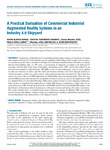Mostrar o rexistro simple do ítem
A Practical Evaluation of Commercial Industrial Augmented Reality Systems in an Industry 4.0 Shipyard
| dc.contributor.author | Blanco, Óscar | |
| dc.contributor.author | Fernández-Caramés, Tiago M. | |
| dc.contributor.author | Fraga-Lamas, Paula | |
| dc.contributor.author | Vilar-Montesinos, Miguel A | |
| dc.date.accessioned | 2024-01-30T09:18:23Z | |
| dc.date.available | 2024-01-30T09:18:23Z | |
| dc.date.issued | 2018 | |
| dc.identifier.citation | O. Blanco-Novoa, T. M. Fernandez-Carames, P. Fraga-Lamas, y M. A. Vilar-Montesinos, «A Practical Evaluation of Commercial Industrial Augmented Reality Systems in an Industry 4.0 Shipyard», IEEE Access, vol. 6, pp. 8201-8218, 2018, doi: 10.1109/ACCESS.2018.2802699. | es_ES |
| dc.identifier.issn | 2169-3536 | |
| dc.identifier.uri | http://hdl.handle.net/2183/35225 | |
| dc.description.abstract | [Absctract]: The principles of the Industry 4.0 are guiding manufacturing companies toward more automated and computerized factories. Such principles are also applied in shipbuilding, which usually involves numerous complex processes whose automation will improve its efficiency and performance. Navantia, a company that has been building ships for 300 years, is modernizing its shipyards according to the Industry 4.0 principles with the help of the latest technologies. Augmented reality (AR), which when utilized in an industrial environment is called industrial AR (IAR), is one of such technologies, since it can be applied in numerous situations in order to provide useful and attractive interfaces that allow shipyard operators to obtain information on their tasks and to interact with certain elements that surround them. This article first reviews the state of the art on IAR applications for shipbuilding and smart manufacturing. Then, the most relevant IAR hardware and software tools are detailed, as well as the main use cases for the application of IAR in a shipyard. Next, it is described Navantia's IAR system, which is based on a fog-computing architecture. Such a system is evaluated when making the use of three IAR devices (a smartphone, a tablet, and a pair of smart glasses), two AR software development kits (ARToolKit and Vuforia) and multiple IAR markers, with the objective of determining their performance in a shipyard workshop and inside a ship under construction. The results obtained show a remarkable performance differences among the different IAR tools and the impact of factors like lighting, pointing out the best combinations of markers, and hardware and software to be used depending on the characteristics of the shipyard scenario. | es_ES |
| dc.language.iso | eng | es_ES |
| dc.publisher | IEEE | es_ES |
| dc.relation.uri | https://doi.org/10.1109/ACCESS.2018.2802699 | es_ES |
| dc.rights | Atribución 3.0 España | es_ES |
| dc.rights.uri | http://creativecommons.org/licenses/by/3.0/es/ | * |
| dc.subject | Augmented Reality | es_ES |
| dc.subject | Cyber-physical systems | es_ES |
| dc.subject | Identification | es_ES |
| dc.subject | Industrial augmented reality | es_ES |
| dc.subject | Industry 4.0 | es_ES |
| dc.subject | Internet of Things | es_ES |
| dc.subject | Traceability | es_ES |
| dc.subject | Industrial Internet of Things | es_ES |
| dc.subject | Smart factory | es_ES |
| dc.title | A Practical Evaluation of Commercial Industrial Augmented Reality Systems in an Industry 4.0 Shipyard | es_ES |
| dc.type | info:eu-repo/semantics/article | es_ES |
| dc.rights.access | info:eu-repo/semantics/openAccess | es_ES |
| UDC.journalTitle | IEEE Access | es_ES |
| UDC.volume | 6 | es_ES |
| UDC.startPage | 8201 | es_ES |
| UDC.endPage | 8218 | es_ES |
Ficheiros no ítem
Este ítem aparece na(s) seguinte(s) colección(s)
-
GI-GTEC - Artigos [190]






